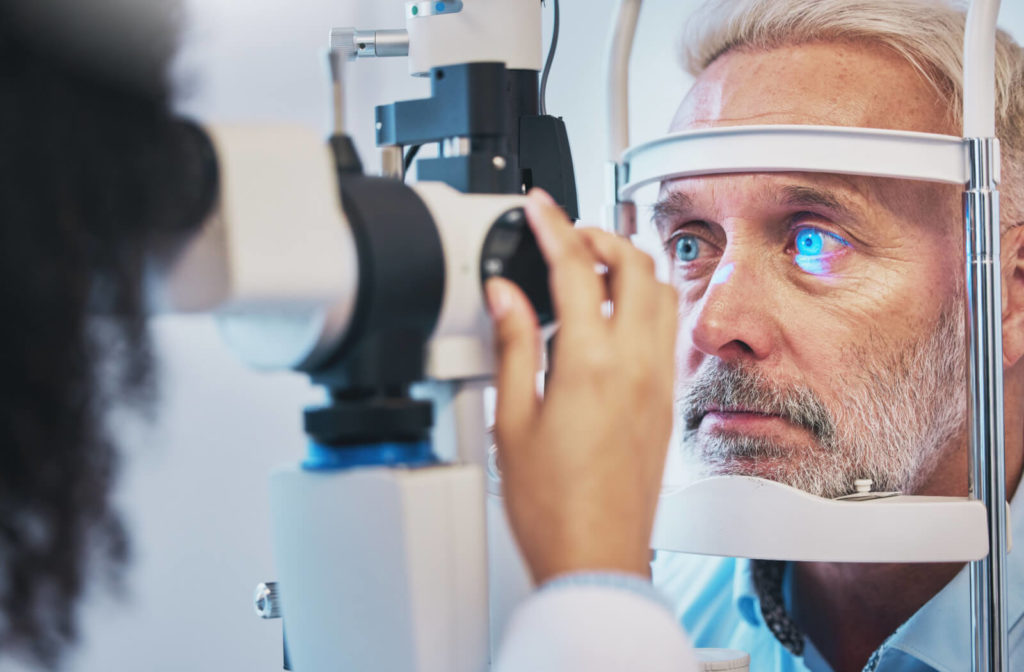Did you know that having diabetes can affect your eye health? Eye doctors carefully work with patients who have diabetes to support their overall health, including tracking the development of any eye disorders and assisting in developing a strategy to maintain healthy vision for life.
A diabetic eye exam is a check-up for those with diabetes to monitor their eye health and identify diabetes-related eye problems.
What Is Diabetes?
Diabetes is a chronic condition that inhibits the body from producing or using insulin, resulting in elevated blood sugar levels. Because the eye has such small blood vessels, they’re particularly susceptible to changes in blood sugar levels.
Diabetes affects roughly 3.7 million Canadians and is expected to affect 4.9 million Canadians by 2030. Diabetes is also one of the leading causes of blindness.
Diabetic Retinopathy
Diabetic retinopathy is a serious eye condition that occurs when there’s damage to the retina caused by diabetes. It may appear without causing symptoms initially, so regular eye exams are essential.
As diabetic retinopathy worsens, it can lead to symptoms like:
- Dark dots in your vision
- Hazy or fluctuating vision
- Colour alterations in your vision
- Loss of vision
If your optometrist diagnoses you with diabetic retinopathy, they may refer you to an ophthalmologist and more advanced care to prevent blindness or vision loss.
Diabetic retinopathy is the major cause of loss of vision in adults. Loss of vision links to increased falls, hip fractures, and a fourfold increase in mortality. Diabetic retinopathy affects around 25.1% of Canadians.
When to Book a Diabetic Eye Exam
We recommend our patients with diabetes undergo a diabetic eye exam at least once a year, although every person and situation is unique, so this may be different for you.
Your eyes are an insight into your health, and an eye exam can uncover problems with your overall health.
What to Expect During a Diabetic Eye Exam
Diabetic eye exams are comparable to routine eye exams, but they pay special attention to the health of your retina and the quality of the blood vessels in your eyes.
Unlike routine eye exams, however, diabetic eye exams are partially covered by MSP since they’re deemed medically necessary.
Pupil Dilation
During a diabetic eye exam, special eye drops are used to dilate your pupils, allowing your optometrist to gain a clear view of your retina, optic nerve, and blood vessels at the back of the eye.
The dilation eye drops cause temporary near-vision blurriness and light sensitivity, and they take around 15 to 20 minutes to start working. Most of the time, these side effects go away within a few hours. Do not be alarmed if one eye recovers faster than the other.
Fundoscopy
A fundoscopy refers to an examination of the back of the eye and is done using one or more of the methods or instruments listed below:
- An indirect ophthalmoscope is a combination of a strong light on a headpiece worn by your eye doctor and a hand-held lens held right next to your eye. This equipment allows your eye doctor to see your retina and the back of your eye from a much broader angle.
- A slit lamp ophthalmoscope uses a table-mounted slit lamp to examine your eye and gives your eye doctor a significantly magnified, 3D view of specific portions of your retina, retinal blood vessels, and optic nerve.
- Ultra-wide field retinal imaging (such as the Optomap of ZEISS Clarus retinal imaging) captures comprehensive images of the retina and its layers, allowing your eye doctor to assess the retinal periphery in greater detail.
- Optical Coherence Tomography (OCT) analyzes the retinal layers for any swelling or underlying hemorrhages.
Fluorescein Angiography
Fluorescein angiography may be performed when we refer a patient with diabetes to a retinal specialist ophthalmologist. This assessment detects damaged blood vessels in the eye.
A unique dye will be administered in your arm and will pass through the bloodstream to your eyes, revealing any damage to your blood vessels. A specifically devoted camera will then photograph any damage discovered for simple identification.

How to Lower Your Risk of Diabetic Retinopathy
To reduce your risk of diabetic retinopathy, aim to maintain your target blood sugar, blood pressure, and cholesterol levels. Your family doctor can inform you of your target ranges. And don’t forget to book regular diabetic eye exams.
Manage Your Diabetes. Manage Your Vision.
High blood sugar, particularly when not managed properly over time, can damage the fragile blood vessels in your eyes as well as blood vessels throughout your body.
When you have diabetes, controlling your blood sugar is critical to protecting your vision. Diabetes puts you at risk for eye disorders and other issues.
Booking regular eye exams is one of the steps in prevention, and maintaining regular diabetic eye exams is one of the steps in controlling and maintaining your overall health. Make an appointment with Discover Eyecare today!



